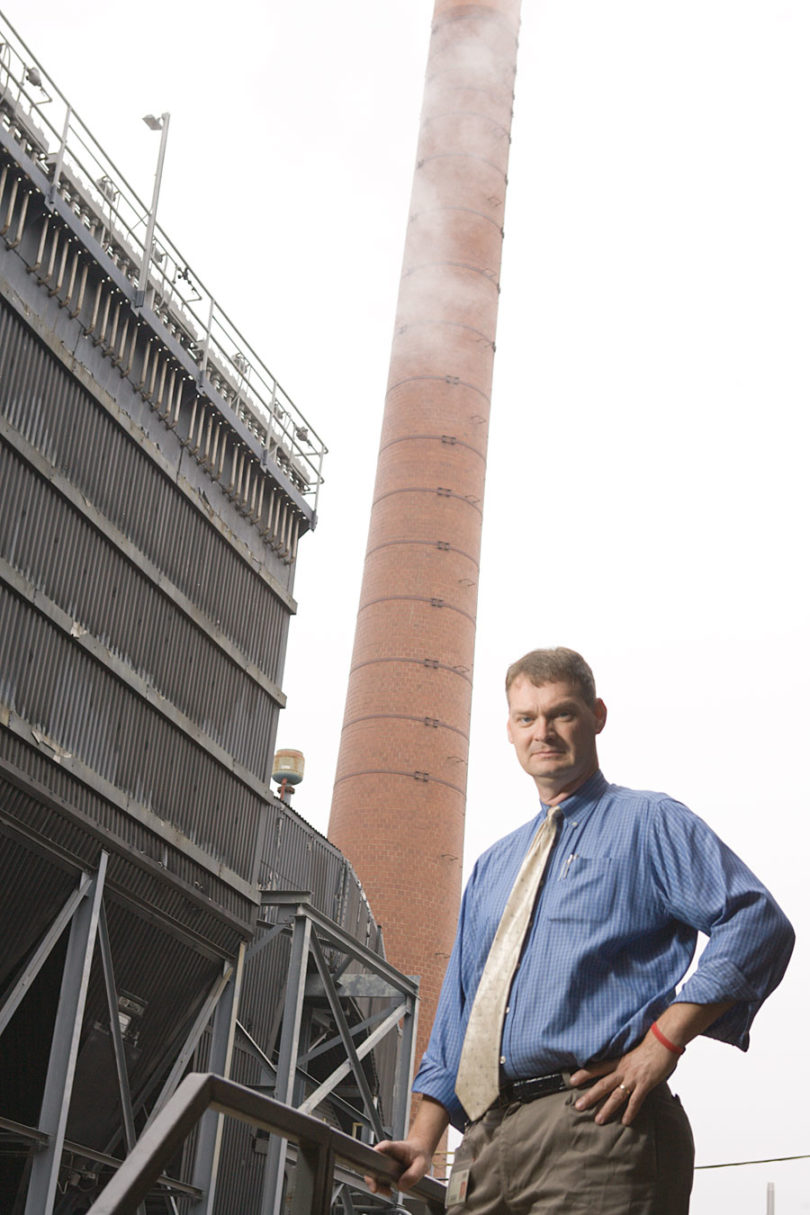It takes a lot of energy to power a major research campus like UGA. In fact, with residence halls, classrooms, offices and research facilities, the university uses as much electricity as 15,000 homes. The energy systems for a campus are very different from residential energy use and as part of Energy Conservation Month, Columns sat down with Ken Crowe, director of energy services, to discuss the university’s district energy concept and behind-the-scenes energy plans for campus.
Columns: What is district energy?
Crowe: The district energy concept is where energy is produced at a central location and distributed by underground piping throughout a defined geographic area. UGA uses this for steam, and we are starting to develop this concept for chilled water as well.
District energy has traditionally been used on large, densely populated campuses across the nation to increase the reliability of heating and cooling systems, reduce maintenance costs and reduce energy costs. All of UGA’s peer institutions use district energy to some extent.
UGA has used district energy since the 1930s or 1940s at the central steam plant. Since the 1980s, the university has installed chilled water piping for district cooling by connecting chillers in existing buildings.
Columns: Is district energy used all over campus?
Crowe: We have some level of district systems on all areas of campus. The steam system is a true district system with one central plant. The cooling system is more of a distributed system for distinct areas of campus (north, south, etc.) because there are currently no central plants for cooling.
Columns: How does the Central Steam Plant figure into the future of district energy?
Crowe: The UGA central steam system currently uses three fuels for steam production: natural gas, heating oil and coal. Having three fuels allows UGA to produce energy in the most reliable, cost effective manner. Using three types of fuel makes sense, especially in the event one of the fuels is unavailable. For example, after Hurricane Katrina in 2005, both natural gas and heating oil were unavailable for approximately one week so coal was used as it was the only source of fuel. If steam had been unavailable for this week, many of the necessary functions on campus would have ceased: hot water for the residence halls and dining facilities, the ability to maintain temperatures in research animal facilities and the sterilization for critical components in research labs and the veterinary hospital.
In addition, since most steam on campus is produced by burning natural gas, coal is used mainly during the winter when steam demand is higher and there is increased cost for natural gas. Also, when extreme cold hits the northeast U.S., natural gas is sometimes unavailable as the pipelines limit supply. UGA is currently exploring alternative technologies for coal use, including biomass options.
Columns: Are any new steam lines in the works?
Crowe: A steam line is nearly complete that will tie in much of East Campus to the main campus steam system. This will reduce energy use and maintenance costs by eliminating individual boiler units at the Performing and Visual Arts complex. The steam also will be available for future facilities on East Campus. The new line will increase the reliability of heating on this part of campus and lower its cost.
Columns: How do you plan to adopt a true district energy concept for cooling?
Crowe: At UGA, much of the piping network for district cooling is currently in place. The plans are to develop district cooling plants to utilize this piping network as chilled water producing units (chillers) in buildings need to be replaced.
New chillers will be installed in district plants, not individual buildings, because having fewer chiller locations translates to lower maintenance costs. The implementation of district plants on campus would mean that we would have fewer cooling towers, and that means lower water usage. The district chillers would be more efficient, i.e. fewer machines running at optimum levels, and would therefore help to lower energy costs.
Columns: What’s happening to the South Campus area?
Crowe: A new district cooling plant was developed for South Campus and became operational this summer. The plant contains two 1,000-ton chillers that use environmentally-friendly refrigerants. This plant lowered the energy use for buildings on South Campus by 25 percent this summer for an annual cost savings of $350,000.
Columns: What is happening with the expansion of the Northwest Precinct on campus?
Crowe: The Northwest Central Utility Plant design is nearly complete. When built, it will provide heating and cooling to new facilities to be constructed in the new Northwest Precinct of campus, including the area around the planned Special Collections Library. It will connect into main campus and increase the efficiency of existing air conditioning systems by as much as 35 percent. This will eliminate the need for a large mechanical space in new facilities; therefore, more of the building space can be dedicated to academic functions.
Columns: What planning is being done for future energy needs?
Crowe: Due to the growing campus and aging systems, opportunities exist to upgrade the current district energy system with more efficient technology in the future. UGA is committed to fiscal and environmental stewardship in the way that we provide future energy to the campus. Decisions on new systems will need to consider several elements: location, fuel availability, air quality, aesthetics, capital funding and operating costs.







